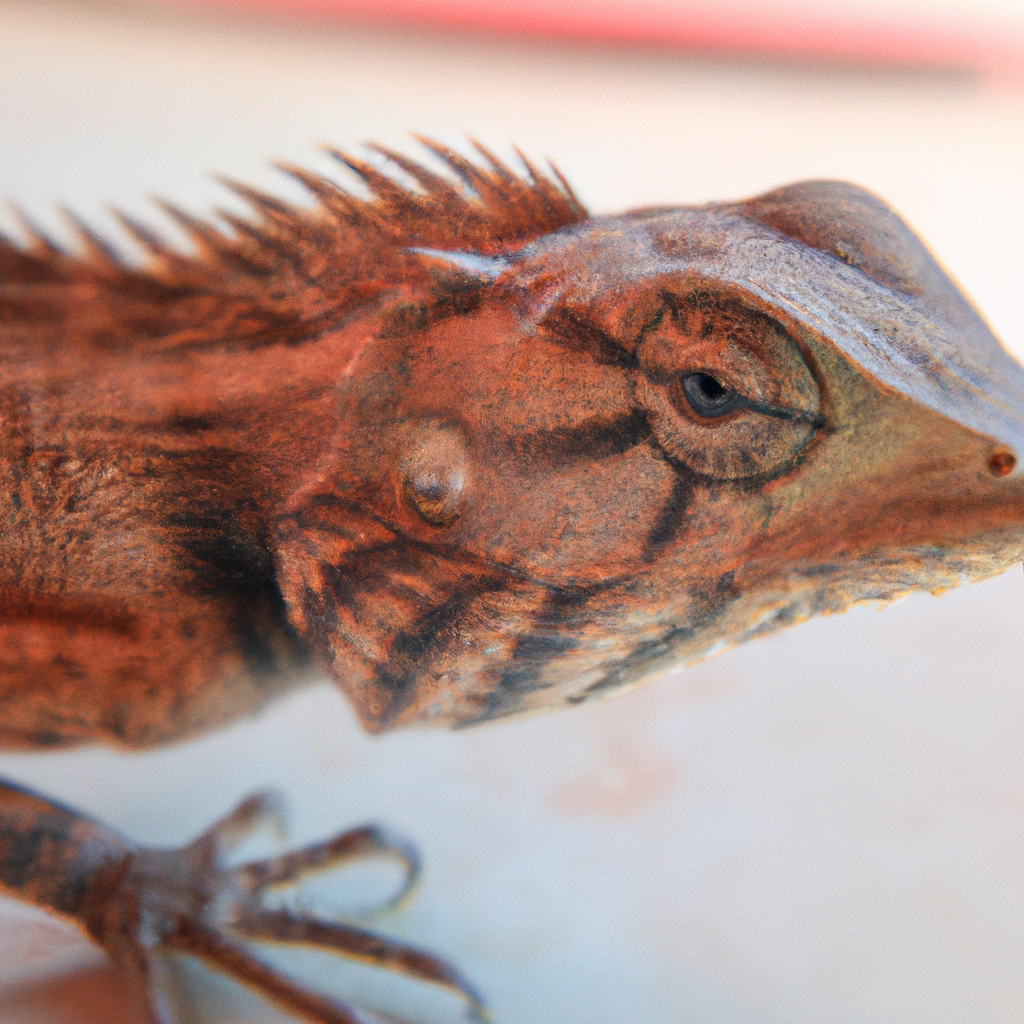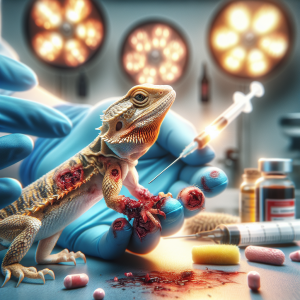Understanding Lizard Behavioral Issues
You know, when it comes to our scaly friends, understanding their behavior is so crucial. It’s not just about making sure they’re well-behaved pets; it goes much deeper than that. By delving into lizard behavioral issues, we’re actually gaining valuable insights into their overall health and well-being.
Think about it – when a lizard starts acting out of character, it could be a sign that something is amiss. Maybe they’re feeling stressed, unwell, or even lonely. By recognizing these behavioral cues and addressing them promptly, we’re not just improving their behavior; we’re also potentially preventing more serious health issues down the line.
Plus, understanding lizard behavior can also enhance our bond with these fascinating creatures. When we take the time to observe and interpret their actions, we’re essentially communicating with them in their own unique language. It’s like unlocking a whole new level of connection that goes beyond just being their caregiver.
And let’s not forget the positive impact this knowledge can have on the reptile community as a whole. By sharing our experiences and insights into lizard behavioral issues, we’re contributing to a collective pool of knowledge that can benefit all lizard owners. We’re creating a supportive network where we can learn from each other and ensure that our scaly companions lead happy and fulfilling lives.
So, the next time your lizard starts behaving oddly, don’t just brush it off as quirky behavior. Take a moment to dig deeper, understand what they’re trying to tell you, and see how you can help them thrive. Because when we truly grasp the significance of lizard behavioral issues, we’re not just caring for our pets – we’re fostering a deeper connection and making a positive impact in the reptile world.
Common Signs of Behavioral Problems
Did you know that lizards are masters of body language? When it comes to understanding their behavioral issues, paying attention to their subtle cues can speak volumes. Imagine this – you’re observing your lizard and notice some unusual behaviors. Maybe they’re pacing back and forth, displaying aggressive postures, or even refusing to eat. These could be signs of underlying behavioral problems that require attention.
Understanding the common signs of behavioral issues in lizards is crucial for their well-being. It’s like deciphering a secret code that your scaly friend is trying to communicate. For instance, sudden changes in appetite, excessive hiding, or constant tail twitching can all indicate stress, illness, or discomfort.
I remember a time when my bearded dragon, Spike, started acting out of character. He used to be a social butterfly, always basking under his heat lamp, but suddenly he became withdrawn and seemed agitated. It was a puzzling situation, and I had to figure out what was bothering him. That’s when I learned the importance of recognizing and addressing behavioral changes promptly.
By being aware of these behavioral red flags, you can take proactive steps to address the root cause. Whether it’s creating a more enriching environment, adjusting their feeding schedule, or seeking professional advice, there are various solutions to help your lizard thrive.
So, next time you observe your lizard exhibiting unusual behaviors, remember that they might be trying to tell you something. Stay curious, observe closely, and be proactive in addressing any behavioral issues they may be facing. After all, a happy and healthy lizard is a joy to have as a part of your family!
Causes of Lizard Behavioral Issues
You know, when it comes to understanding the causes of lizard behavioral issues, it’s not just about fixing a single problem. It’s about delving deeper into the bigger picture and recognizing the significance of these issues in the overall health and well-being of our scaly friends.
Imagine this – your lizard starts exhibiting unusual behaviors like excessive aggression or refusing to eat. It’s easy to dismiss these as minor quirks, but these could actually be signs of underlying health issues or environmental stressors that need to be addressed promptly. By understanding the root causes of these behavioral issues, we can not only improve our lizard’s quality of life but also strengthen the bond we share with our unique pets.
Exploring the broader implications of lizard behavioral issues allows us to become better caregivers and advocates for our reptilian companions. It’s like peeling back the layers of a mystery to reveal the hidden clues that can lead us to solutions. By taking the time to investigate and understand why our lizards may be behaving a certain way, we are not only helping them but also deepening our connection and communication with these fascinating creatures.
So, next time your lizard displays an unusual behavior, don’t just brush it off as a one-time thing. Take a moment to consider the broader implications of what that behavior might signify. Is it a cry for help? A reaction to a change in their environment? By looking at the bigger picture, we can provide better care and support for our scaly companions, ensuring they lead happy and fulfilling lives in our homes.
Importance of Addressing Behavioral Problems
You know, I once had a lizard that started displaying some unusual behaviors out of the blue. It was quite a puzzling situation because my little buddy had always been so well-behaved. That experience really made me realize the importance of addressing lizard behavioral issues promptly. It’s like their way of communicating with us, telling us that something is not quite right in their world.
When you notice your lizard acting out of character, it can be easy to brush it off as just a phase. But trust me, it’s crucial to address these behavioral problems early on before they escalate. Ignoring them could lead to more serious issues down the road and impact your lizard’s overall well-being.
So, let’s dive into why addressing lizard behavioral problems is so important. Think of it as decoding your lizard’s language – understanding what they’re trying to tell you through their actions. By identifying and tackling these issues head-on, you’re not only improving your lizard’s quality of life but also strengthening the bond you share with your scaly companion.
Remember, each lizard is unique, and their behaviors can vary based on factors like species, age, and environment. By taking the time to address and resolve any behavioral issues they may be facing, you’re not only ensuring their happiness but also creating a harmonious and fulfilling relationship with your reptilian friend.
Tips for Preventing Behavioral Issues
Have you ever thought about how we can prevent behavioral issues in our pet lizards? It’s actually quite fascinating! One practical tip I’ve learned is the importance of creating a suitable environment for our scaly friends. Lizards are incredibly sensitive to their surroundings, and an improper habitat can often lead to stress and behavioral problems.
By providing your lizard with a well-designed enclosure that mimics their natural habitat, you can help prevent behavioral issues from arising. Make sure to include hiding spots, climbing structures, and appropriate heating and lighting elements to ensure their physical and mental well-being. This not only encourages natural behaviors but also reduces the likelihood of stress-related behaviors such as aggression or excessive hiding.
Additionally, maintaining a consistent routine for feeding, handling, and interaction is crucial for preventing behavioral issues in lizards. Lizards thrive on predictability and structure, so establishing a regular schedule can help them feel secure and reduce the chances of developing anxious or aggressive behaviors.
It’s also essential to observe your lizard’s behavior closely and address any changes promptly. Sudden shifts in behavior, such as decreased appetite, excessive hiding, or aggression, could indicate underlying issues that need to be addressed. By staying vigilant and responsive to your lizard’s needs, you can intervene early and prevent minor behavioral issues from escalating into more significant problems.
Remember, each lizard is unique, so it’s essential to tailor your care and interactions to suit their individual preferences and personalities. Building a strong bond with your lizard based on trust and understanding can go a long way in preventing behavioral issues and fostering a happy and healthy relationship with your scaly companion.
Effective Solutions for Lizard Behavior
Let me share some insights on effective solutions for addressing lizard behavior. One key aspect to consider is providing behavioral enrichment for your scaly friend. Just like us, lizards need mental stimulation and variety in their environment to thrive.
Imagine this – when I introduced a new climbing branch in my lizard’s enclosure, I noticed a positive change in its behavior. It became more active, exploring its new surroundings with curiosity. This simple addition helped reduce any signs of stress or boredom that my lizard was exhibiting.
Incorporating interesting elements like different textures, hiding spots, or interactive toys can make a significant difference in your lizard’s behavior. Did you know that some lizards enjoy puzzles or foraging activities to keep them engaged mentally and physically? It’s fascinating how these small additions can bring out the best in our reptilian companions.
To address lizard behavioral issues effectively, it’s crucial to understand your pet’s natural behaviors and preferences. By creating a stimulating environment that mimics their natural habitat, you can promote their well-being and prevent behavioral problems. So, why not try adding a new element to your lizard’s enclosure today and observe how it positively impacts their behavior?
Remember, providing behavioral enrichment is not just about keeping your lizard entertained; it’s about promoting their overall health and happiness. By investing time and effort into creating a stimulating environment, you can build a stronger bond with your lizard and ensure they lead a fulfilling life in captivity.
Behavioral Enrichment for Lizards
Have you ever thought about the broader impact of providing behavioral enrichment for your pet lizard? It’s not just about keeping them entertained or preventing boredom—it’s about ensuring their overall well-being and mental health. By incorporating activities and environmental stimuli that encourage natural behaviors, you are essentially promoting a more fulfilling and enriching life for your scaly friend.
When you engage your lizard in behavioral enrichment activities, you are not only addressing their immediate behavioral needs but also contributing to their long-term health and happiness. Just like us, lizards thrive when they have opportunities to express their natural instincts and behaviors. By creating a stimulating environment that mimics their natural habitat, you are helping them lead a more fulfilling and satisfying life.
Moreover, providing behavioral enrichment for your lizard can strengthen the bond between you and your pet. When you actively engage with your lizard through interactive activities and enrichment opportunities, you are building trust and fostering a deeper connection. This can lead to a more positive and rewarding relationship, where both you and your lizard benefit from the enriching experiences you share together.
So, the next time you set up a new climbing branch or introduce a foraging activity for your lizard, remember that you are not just providing a momentary distraction. You are enhancing their quality of life, promoting their well-being, and strengthening the bond you share. Behavioral enrichment is not just a fun activity—it’s a meaningful and impactful way to care for your beloved lizard companion.
Seeking Professional Help for Severe Behaviors
Let’s delve into the topic of seeking professional help for severe lizard behaviors. It’s essential to remember that just like us, lizards can sometimes face complex issues that require expert intervention. Share a personal anecdote or experience related to VIII.
I once had a friend who was struggling with her bearded dragon’s aggressive behavior. No matter what she tried, the lizard seemed stressed and would lash out unpredictably. It was a challenging situation for her, as she wanted her pet to feel safe and happy in their home.
When she finally decided to seek professional help from a reptile behavior specialist, it made a world of difference. The expert was able to identify underlying causes for the aggression and provided a tailored behavior modification plan. With dedicated guidance and support, my friend saw gradual improvements in her lizard’s demeanor.
This experience taught me the importance of not hesitating to reach out to professionals when dealing with severe behavioral issues in lizards. These experts have the knowledge and skills to assess the situation objectively and offer specialized solutions that can benefit both the lizard and its owner.
Remember, seeking professional help is not a sign of failure but a proactive step towards resolving challenging behaviors and fostering a harmonious relationship with your scaly companion. So, if you find yourself facing persistent or concerning behaviors in your lizard, don’t hesitate to consult a reptile behavior specialist for guidance and support.
Monitoring Progress and Adjusting Strategies
Let me share some insights on monitoring progress and adjusting strategies when addressing lizard behavioral issues. It’s crucial to keep track of any changes in your lizard’s behavior after implementing solutions. Think of it as a trial-and-error process, where you observe how your lizard responds to the adjustments you’ve made.
One practical tip I’ve found helpful is maintaining a behavior log. This log can include details such as the specific behaviors you’re targeting, the strategies you’re using to address them, and any changes you notice in your lizard’s behavior over time. By documenting these observations, you can better understand what is working and what may need further refinement.
Remember, progress may not always be linear. Just like humans, lizards can have good days and bad days. It’s essential to be patient and persistent in your efforts to modify their behavior positively. If you encounter setbacks or challenges along the way, don’t get discouraged. Instead, use them as learning opportunities to adjust your approach and try new techniques.
By regularly reviewing your behavior log and reflecting on the progress made, you can fine-tune your strategies to better meet your lizard’s needs. This iterative process allows you to adapt and tailor your interventions based on your lizard’s responses, ultimately leading to more effective outcomes.
So, whether you’re working on curbing aggressive behavior, reducing stress-related behaviors, or promoting positive interactions, monitoring progress and adjusting strategies is key to successfully addressing lizard behavioral issues. By staying attentive, flexible, and proactive, you can create a harmonious environment for your lizard to thrive.
Maintaining a Positive Relationship with Your Lizard
Let’s delve into the topic of “Maintaining a Positive Relationship with Your Lizard.” Building a strong bond with your scaly friend is key to their well-being and your enjoyment as a pet owner.
When it comes to maintaining a positive relationship with your lizard, I can’t help but recall a personal anecdote. I remember when my bearded dragon, Spike, would shy away from me whenever I approached his terrarium. It took time and patience to earn his trust, but eventually, he would eagerly crawl onto my hand for some quality bonding time.
Developing a positive relationship with your lizard involves more than just providing food and shelter. Did you know that lizards are sensitive to their environment and the energy you project? Your body language, tone of voice, and interactions with them play a significant role in fostering trust and companionship.
One practical tip I can offer is to create a routine that includes daily interactions with your lizard. Regular handling, feeding, and playtime can help strengthen your bond and make your lizard feel more secure in your presence. Remember, consistency is key when it comes to building trust.
Now, let’s explore a thought-provoking question: Have you ever considered the emotional intelligence of lizards? While they may not express emotions in the same way as dogs or cats, lizards are capable of forming attachments and recognizing their caregivers. Understanding their unique communication cues and responding to their needs can deepen your relationship with these fascinating creatures.
In conclusion, maintaining a positive relationship with your lizard goes beyond meeting their basic needs. It requires patience, empathy, and a willingness to learn and adapt to their individual personalities. By investing time and effort into building trust and mutual respect, you can enjoy a rewarding and fulfilling connection with your scaly companion.



